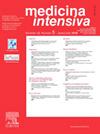根据脓毒症重症患者的乳酸、降钙素原和钙黏蛋白联合序列水平建立死亡率预测模型:根据败血症-3 定义进行的回顾性研究
IF 2.7
4区 医学
Q2 CRITICAL CARE MEDICINE
引用次数: 0
摘要
目标1)评估基线和24小时血清钙蛋白与典型生物标志物(乳酸和降钙素原)相比,对重症脓毒症患者28天死亡率的预后能力;以及2)建立一个结合三种生物标志物的预测模型。干预措施测量基线乳酸、降钙素原和钙黏蛋白水平,以及24小时的降钙素原和钙黏蛋白水平。主要关注变量人口统计学和合并症,入ICU时的SOFA评分,入院时和24小时的基线乳酸、降钙素原和钙黏蛋白水平,以及28天的死亡率。结果1)在重症监护室入院时,乳酸盐是唯一一个具有显著准确性的生物标志物(AUC:0.698);2)在 24 小时内,降钙素原和钙蛋白水平没有发现差异。非幸存者的降钙素原和钙黏蛋白清除率明显较低,两者均达到中等水平(AUC:分别为 0.668 和 0.664);3)基于生物标记物的模型具有显著的准确性(AUC:0.766),与单独的 SOFA 评分相比呈上升趋势(AUC:0.829);4)基线乳酸水平、降钙素原和钙黏蛋白清除率是预测结果的独立指标。结论1)基线和 24 小时钙蛋白和降钙素水平缺乏预测 28 天死亡率的能力;2)两种生物标记物清除率的准确性一般;3)SOFA 评分与基于生物标记物的预测模型相结合显示出较高的预后准确性。本文章由计算机程序翻译,如有差异,请以英文原文为准。
Mortality prediction model from combined serial lactate, procalcitonin and calprotectin levels in critically ill patients with sepsis: A retrospective study according to Sepsis-3 definition
Objective
1) To evaluate the ability of baseline and on 24 h serum calprotectin, in comparison to canonical biomarkers (lactate and procalcitonin), for prognosis of 28-day mortality in critically ill septic patients; and 2) To develop a predictive model combining the three biomarkers.
Design
A single-center, retrospective study.
Setting
Intensive Care Unit of a university hospital.
Patients or participants
One hundred and seventy three septic pacientes were included.
Interventions
Measurement of baseline lactate, procalcitonin and calprotectin level and procalcitonin and calprotectin levels on 24 h.
Main variables of interest
Demographics and comorbidities, SOFA score on ICU admission, baseline lactate, procalcitonin and calprotectin on admission and on 24 h and 28-day mortality.
Results
1) On ICU admission, lactate was the only biomarker achieving a significant accuracy (AUC: 0.698); 2) On 24 h, no differences were found on procalcitonin and calprotectin levels. Procalcitonin and calprotectin clearances were significantly lower in non-survivors and both achieved a moderate performance (AUCs: 0.668 and 0.664, respectively); 3) A biomarker based-model achieved a significant accuracy (AUC: 0.766), trending to increase (AUC: 0.829) to SOFA score alone; y 4) Baseline lactate levels and procalcitonin and calprotectin clearance were independent predictors for the outcome.
Conclusions
1) Baseline and on 24 h calprotectina and procalcitonin levels lacked ability in predicting 28-day mortality; 2) Accuracy of clearance of both biomarkers was moderate; and 3) Combination of SOFA score and the predictive biomarker based-model showed a high prognostic accuracy.
求助全文
通过发布文献求助,成功后即可免费获取论文全文。
去求助
来源期刊

Medicina Intensiva
CRITICAL CARE MEDICINE-
CiteScore
2.70
自引率
20.00%
发文量
146
审稿时长
33 days
期刊介绍:
Medicina Intensiva is the journal of the Spanish Society of Intensive Care Medicine and Coronary Units (SEMICYUC) and of Pan American and Iberian Federation of Societies of Intensive and Critical Care Medicine. Medicina Intensiva has become the reference publication in Spanish in its field. The journal mainly publishes Original Articles, Reviews, Clinical Notes, Consensus Documents, Images, and other information relevant to the specialty. All works go through a rigorous selection process. The journal accepts submissions of articles in English and in Spanish languages. The journal follows the publication requirements of the International Committee of Medical Journal Editors (ICMJE) and the Committee on Publication Ethics (COPE).
 求助内容:
求助内容: 应助结果提醒方式:
应助结果提醒方式:


